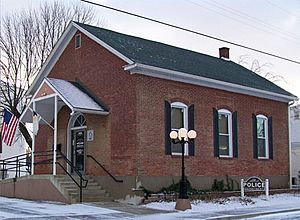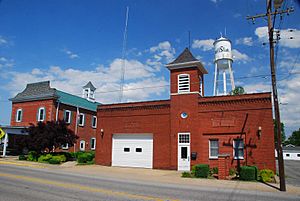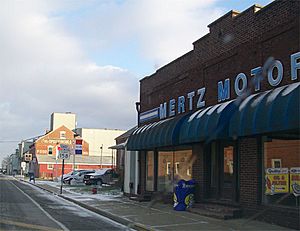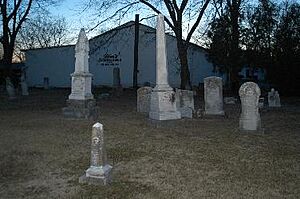Millstadt, Illinois facts for kids
Quick facts for kids
Millstadt
|
|
|---|---|
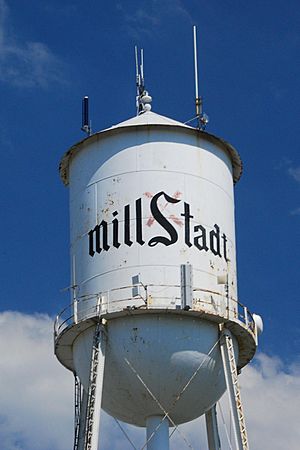
Millstadt Water Tower, no longer used
|
|
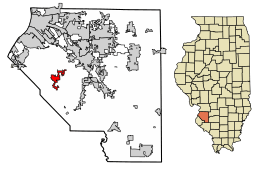
Location of Millstadt in St. Clair County, Illinois.
|
|
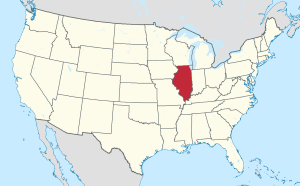
Location of Illinois in the United States
|
|
| Country | United States |
| State | Illinois |
| County | St. Clair |
| Area | |
| • Total | 3.67 sq mi (9.50 km2) |
| • Land | 3.49 sq mi (9.04 km2) |
| • Water | 0.18 sq mi (0.46 km2) |
| Elevation | 600 ft (200 m) |
| Population
(2020)
|
|
| • Total | 4,071 |
| • Density | 1,166.14/sq mi (450.31/km2) |
| Time zone | UTC-6 (CST) |
| • Summer (DST) | UTC-5 (CDT) |
| ZIP Code(s) |
62260/62220
|
| Area code(s) | 618 |
| FIPS code | 17-49386 |
| GNIS feature ID | 2399363 |
| Wikimedia Commons | Millstadt, Illinois |
Millstadt is a village in St. Clair County, Illinois, United States. It is located where two main roads, Illinois Routes 163 and 158, meet.
Millstadt is well-known for its strong German background. More than half of the people living there have German ancestors. In 2020, about 4,071 people lived in the village.
Contents
Village History
In 1836, people decided to start a town on land owned by Henry Randleman. They suggested calling it "Centerville." This name was chosen because the spot was exactly in the middle of Belleville, Columbia, and Pittsburg Lake. The town's plan was officially set on March 13, 1837.
In 1880, the town's name was changed to Millstadt. This happened because another town nearby was already called Centreville, which caused confusion with mail.
Another story about the name change comes from the Millstadt School website. It says that the town's leaders wanted to name it "Mittlestadt" or "Middlestadt." This means "center city" in German. But when they sent the papers to the state, someone misread the writing. The papers came back with the name "Millstadt." Since the town had several mills at that time, the leaders decided to keep the new name.
About the People of Millstadt
| Historical population | |||
|---|---|---|---|
| Census | Pop. | %± | |
| 1880 | 1,229 | — | |
| 1890 | 1,186 | −3.5% | |
| 1900 | 1,172 | −1.2% | |
| 1910 | 1,140 | −2.7% | |
| 1920 | 907 | −20.4% | |
| 1930 | 1,014 | 11.8% | |
| 1940 | 1,290 | 27.2% | |
| 1950 | 1,566 | 21.4% | |
| 1960 | 1,830 | 16.9% | |
| 1970 | 2,168 | 18.5% | |
| 1980 | 2,736 | 26.2% | |
| 1990 | 2,566 | −6.2% | |
| 2000 | 2,794 | 8.9% | |
| 2010 | 4,011 | 43.6% | |
| 2020 | 4,071 | 1.5% | |
| U.S. Decennial Census | |||
In 2000, there were 2,794 people living in Millstadt. These people lived in 1,148 homes, and 813 of these were families. Most of the people in the village were White.
About 31.8% of homes had children under 18 living there. Most homes (59.1%) were married couples living together. About 25.3% of all homes had just one person living in them. The average home had 2.43 people.
The people in Millstadt were of different ages. About 23.7% were under 18 years old. About 17.3% were 65 years or older. The average age in the village was 39 years.
In 2000, the typical household earned about $47,824 each year. The typical family earned about $56,378. A small number of families (3.2%) and people (4.0%) lived with less money.
Where Millstadt Is Located
In 2010, Millstadt covered a total area of about 3.58 square miles. Most of this area (3.41 square miles) was land, and a smaller part (0.17 square miles) was water.
The center of town is where two state highways cross. Illinois Route 158, also called Washington Avenue, goes west to Columbia and east to Belleville. The other main street is Jefferson Avenue. The northern part of Jefferson Avenue is the end of Illinois Route 163. This road goes north to Centreville. The southern part of Jefferson Avenue becomes Floraville Road as it leaves Millstadt.
Local Economy
Millstadt has a modern touch with a solar power system. A 25.5-kilowatt solar array was set up on a barn at Magill Farms in 2021. This system helps create clean energy for the area.
Schools, Churches, and Cemeteries
- Elementary schools:
- Millstadt Primary Center - [1]
- Millstadt Consolidated School - www.millstadt.stclair.k12.il.us
- St. James Catholic School - www.stjames.pvt.k12.il.us
- High schools: (all are in nearby Belleville, Illinois)
- Althoff Catholic High School - www.althoff.net
- Belleville High School-West - www.bths201.org
- Churches in Millstadt:
- Christian Assembly Church (non-denominational)
- Concordia United Church of Christ (United Church of Christ) - [2]
- Countryside Family Church
- St. James Catholic Church (Roman Catholic)
- Trinity Lutheran Church (Missouri Synod) - [3]
- Zion Evangelical Church (Evangelical Association) [4]
- Cemeteries:
- Millstadt Cemetery (also known as Centreville Cemetery) [5]
- Mount Evergreen Cemetery [6]
- St. James Catholic Cemetery [7]
Famous People from Millstadt
Millstadt has been home to several notable individuals, including:
- William N. Baltz, who was a U.S. Representative and also served as Millstadt's mayor.
- Miles Dewey Davis Jr., the father of the famous jazz trumpeter Miles Davis.
- Fred J. Kern, another U.S. Representative.
- Edward P. Petri, who was an Illinois state representative, a sheriff, and a businessman.
- Kevin Schmidt, an Illinois state representative.
- Austin Seibert, a professional football kicker for the Washington Commanders. He played for the Oklahoma Sooners and set a record for the most points scored by a kicker in college football history (FBS).
- Kane Sweeney, the current Head Coach for USC Upstate Spartans baseball.
- Admiral Waldemar F. A. Wendt, a high-ranking officer in the United States Navy.
Sister Cities
Millstadt has a special connection with a town in Germany:
 Groß-Bieberau (Germany)
Groß-Bieberau (Germany)
See also
 In Spanish: Millstadt (Illinois) para niños
In Spanish: Millstadt (Illinois) para niños


